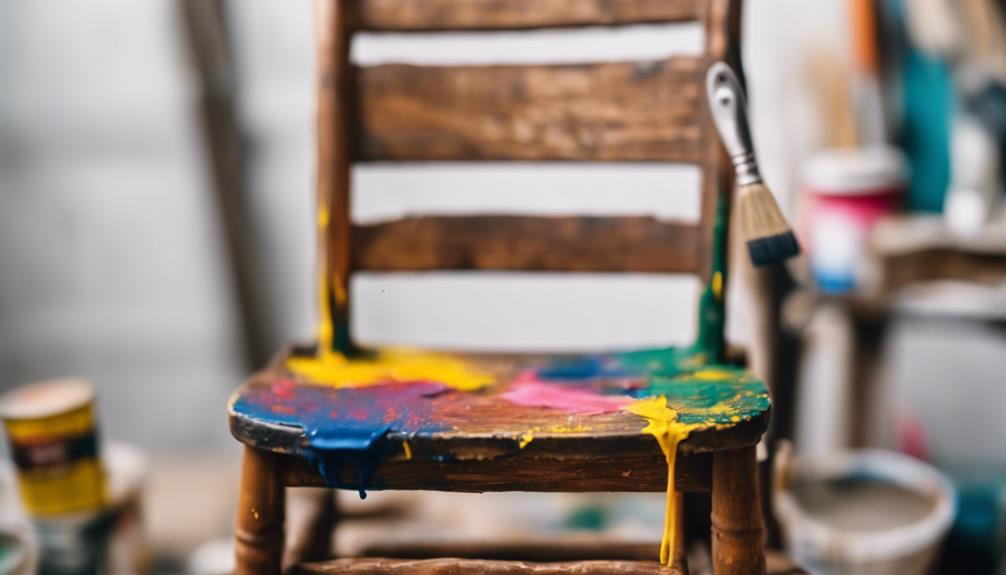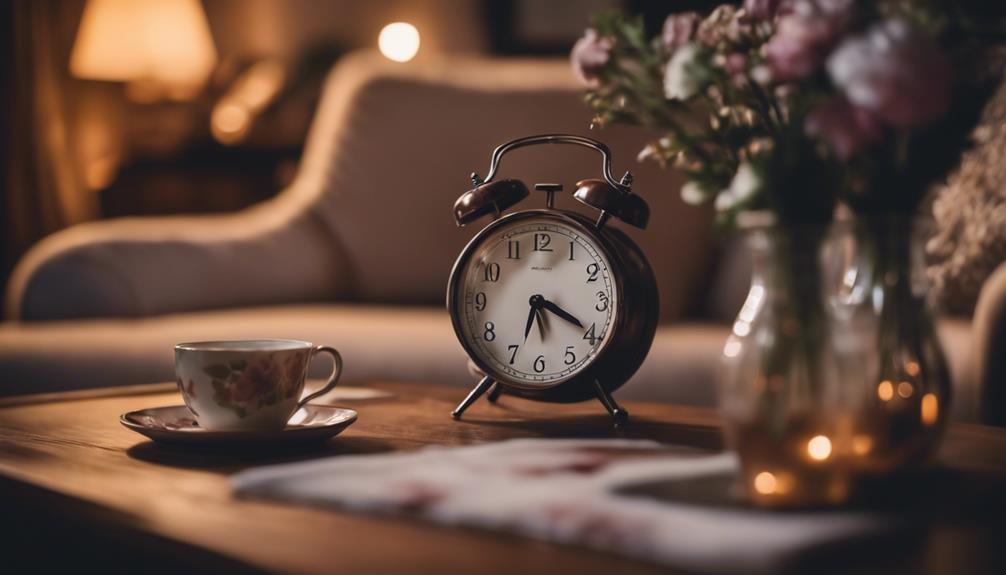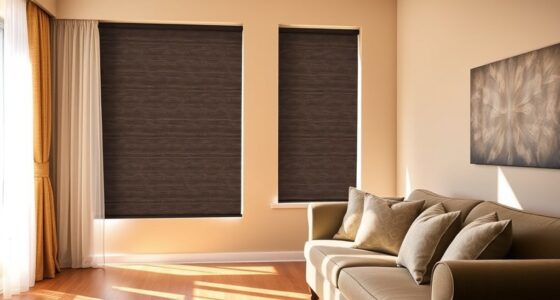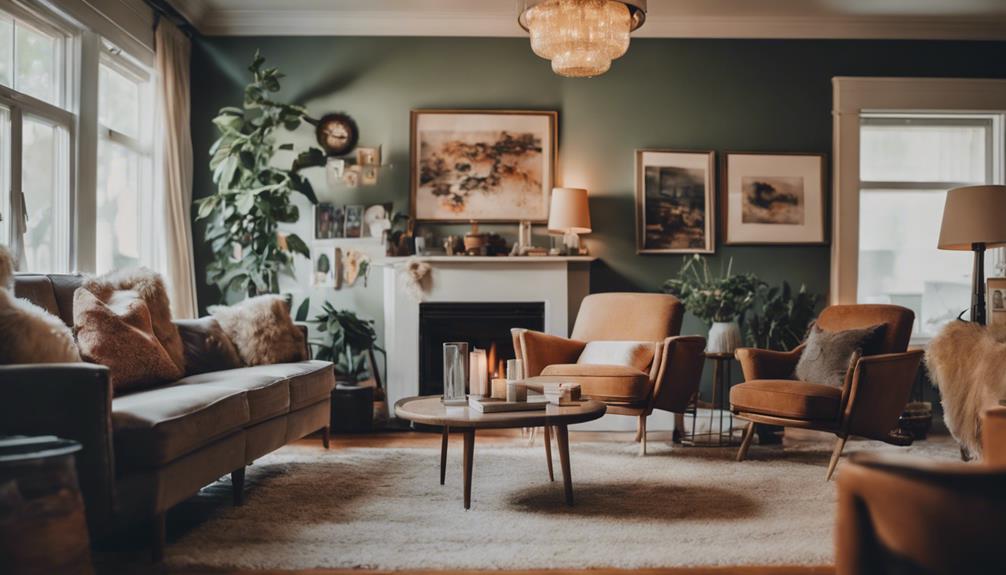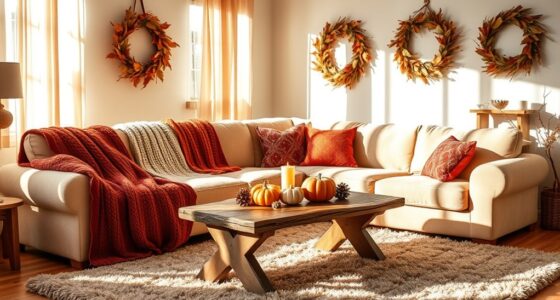Improve your furniture painting skills with our ultimate guide. Start with proper preparation like sanding and priming for a flawless finish. Choose high-quality paints for durability, like Sherwin-Williams Emerald Urethane Trim Enamel. Consider paint compatibility and opt for self-priming options for efficiency. Use traditional chalk paint for decorative looks and exterior paint for outdoor furniture. Essential supplies include sandpapers, primer, quality brushes or rollers, and high-grade paint. Master techniques like brush strokes and color blending for different effects. Discover the importance of surface preparation and quality tools for a professional result. Explore more techniques for a polished look.
Key Takeaways
- Proper preparation is crucial, including sanding and priming for a smooth finish.
- Choose high-quality paint like Sherwin-Williams Emerald Urethane Trim Enamel for durability.
- Consider the type of furniture for paint compatibility and longevity.
- Use self-priming, self-sealing, and self-leveling paints for efficiency and a professional look.
- Invest in quality tools like Purdy White Dove brushes for a polished finish.
Furniture Painting Basics
Let's explore the basics of painting furniture. When it comes to painting furniture, proper preparation is key. Sanding the surface before painting is important as it helps the paint adhere better and gives a more professional finish. Additionally, using a primer before applying the paint is vital to make sure that the paint sticks well and prevents chipping or peeling.
For quality results, it's recommended to use high-quality paint like Sherwin-Williams Emerald Urethane Trim Enamel. This type of paint provides a durable finish that resists chipping, ensuring your furniture stays looking fresh for longer.
Various painting techniques, such as cutting in and rolling paint coats, can help achieve an even and smooth finish on your furniture pieces.
Choosing the Right Paint
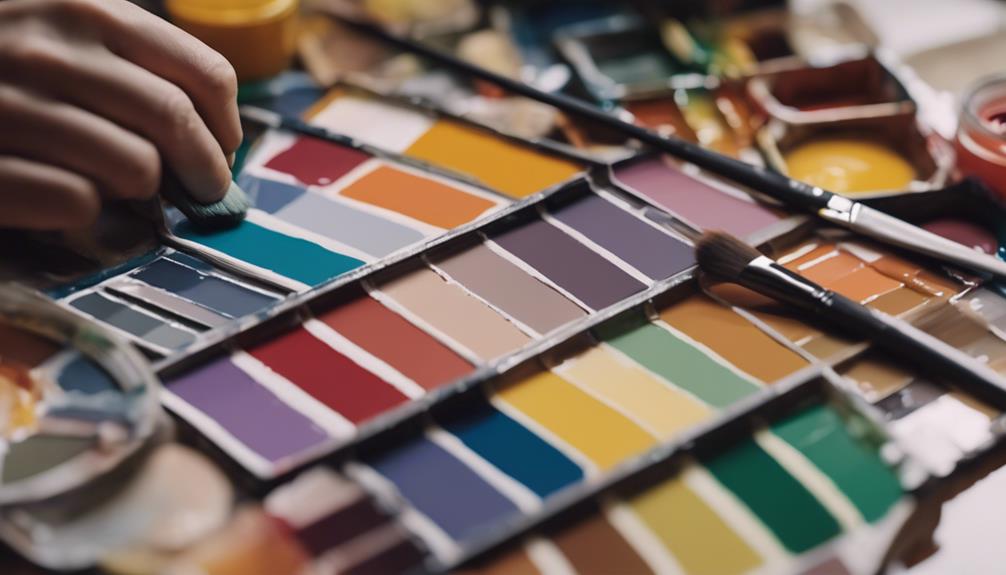
When selecting paint for furniture, it is crucial to consider the type of furniture to ensure compatibility and longevity. Opt for self-priming and self-sealing paints for a more efficient painting process. Additionally, look for self-leveling options to achieve a smooth and professional finish. Traditional chalk paint is ideal for providing decorative or aged looks, adding a unique touch to your furniture. If you plan to paint outdoor furniture, make sure you choose paints specifically designed for exterior use to enhance durability. To help you make an informed decision, below is a comparison table showcasing key features of different types of paints:
| Type of Paint | Features | Best For |
|---|---|---|
| Chalk Paint | Decorative finish | Aged looks |
| Self-Priming | Efficient painting | Saving time |
| Self-Sealing | Protection | Longevity |
Consider these factors when selecting the right paint for your furniture to achieve the desired results.
Preparation Steps

To properly prepare furniture for painting, the first step involves removing all knobs, hinges, and hardware to guarantee a smooth painting process.
Sanding plays a vital role in prepping the furniture, utilizing both 80 grit and 220 grit sandpaper to create a flawless surface for painting. Fine grit sanding sponges are particularly useful for preparing bare wood or laminate furniture, ensuring ideal paint adhesion.
It's essential to address any imperfections by filling them with stainable wood filler before proceeding with painting.
Following these preparation steps diligently is key to a successful furniture painting project, as they set the foundation for a professional-looking finish.
Essential Supplies
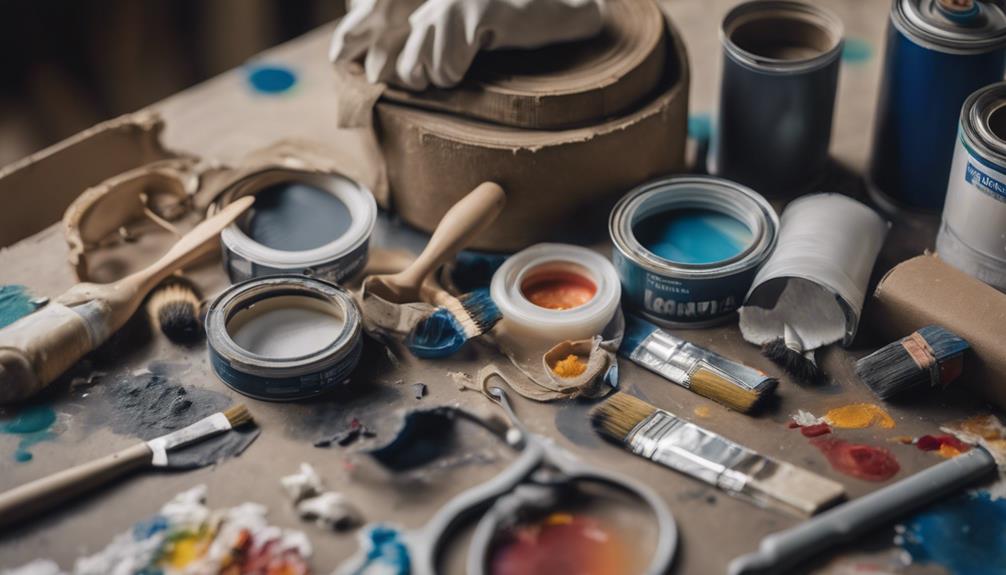
We require essential supplies for furniture painting to guarantee a successful and professional outcome. These supplies include medium and fine grit sandpaper for smoothing surfaces, primer for enhancing paint adhesion, quality paintbrushes or rollers for application, and high-grade paints for a durable finish. Additionally, foam rollers and paint sprayers can be used for a smoother coat if desired. Ensuring the right supplies are used is vital in achieving a professional and long-lasting painted furniture piece.
Proper cleaning with products like Murphys Oil Soap, sanding with the appropriate sandpaper, priming with a suitable primer, and using quality brushes, rollers, and paints are key steps in a successful furniture painting project. Investing in good brushes, rollers, and paints can have a significant impact on the final look and durability of the painted furniture, making it essential to choose the right supplies for the job.
Painting Techniques
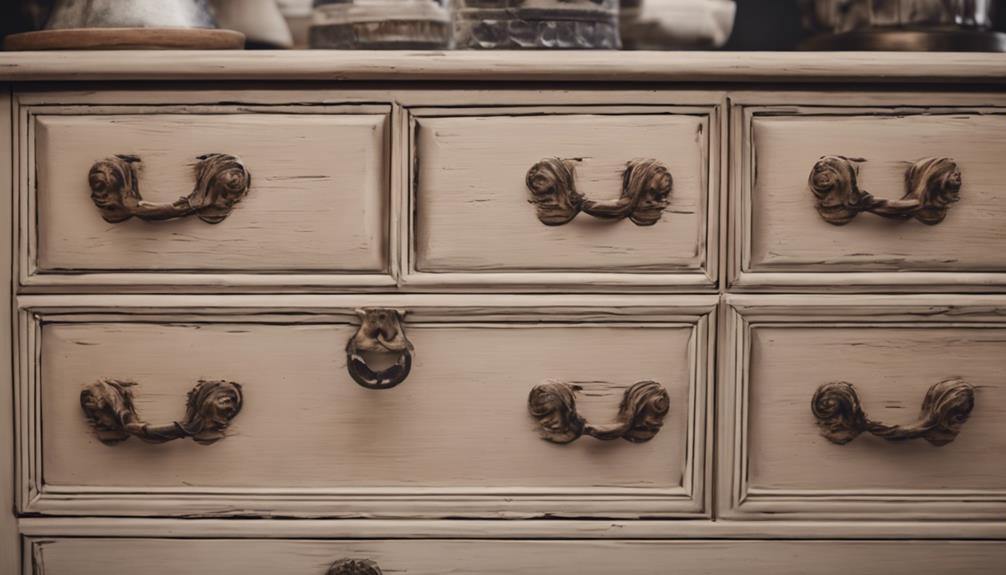
When painting furniture, it's essential to pay attention to brush strokes and color blending techniques. Quality brushes and rollers can help achieve a smooth finish without unwanted textures.
Experimenting with different methods like spraying, rolling, or brushing can offer various effects on your painted furniture.
Brush Strokes
Using high-quality brushes is essential for minimizing visible brush strokes when painting furniture. To achieve a smooth finish and reduce brush marks, it's important to apply paint in the direction of the wood grain.
Overloading the brush with paint can lead to streaks and uneven coverage, so make sure to apply a moderate amount. For an even application and to further decrease brush strokes, consider using a foam roller in addition to brushes.
If you notice any imperfections or brush strokes between coats, lightly sand the surface to smooth them out. This step will help you achieve a more professional-looking result.
Color Blending
Color blending in furniture painting involves the artful mixing of two or more colors to achieve a unique shade or effect. By blending colors on wood furniture, you can create a custom look that adds depth and dimension to your painted furniture pieces. Various techniques such as dry brushing, feathering, or layering can be employed to achieve seamless color blends. Experimenting with different paint colors and application methods is key to mastering the art of color blending on furniture. This process allows for personalization and creativity, transforming your furniture into one-of-a-kind pieces. Check out the table below for a quick reference on color blending techniques:
| Technique | Description | Effect |
|---|---|---|
| Dry Brushing | Applying a small amount of paint with a dry brush | Adds a weathered or distressed look |
| Feathering | Lightly dragging a feathered brush over wet paint | Creates a soft, blended effect |
| Layering | Building up layers of different colors | Provides depth and richness |
Sealing and Finishing Tips
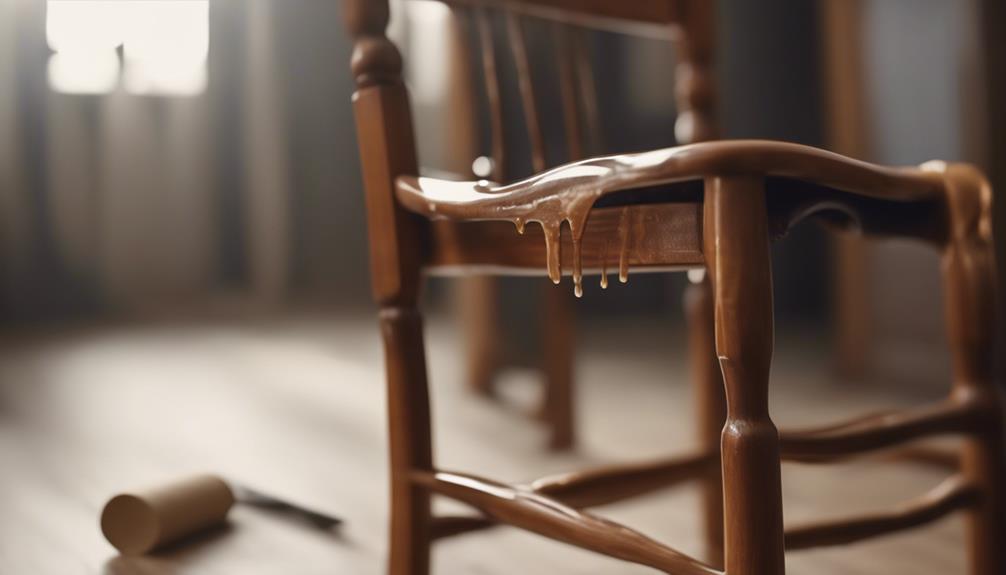
For best protection and longevity of painted furniture, selecting the right sealant and finishing products is essential. The finish and sealant you choose should align with the type of paint used and the level of wear expected on the furniture.
Adding protective topcoats to high-use pieces can greatly prolong the finish, ensuring its durability over time. It's also important to take into account heat resistance when selecting protective topcoats for furniture that may be exposed to high temperatures.
When deciding on colors and finishes, keep in mind their impact on the overall aesthetic of the room where the furniture will be placed. Sealing and finishing not only enhance the visual appeal but also play an important role in maintaining the longevity of painted furniture.
Special Effects and Techniques
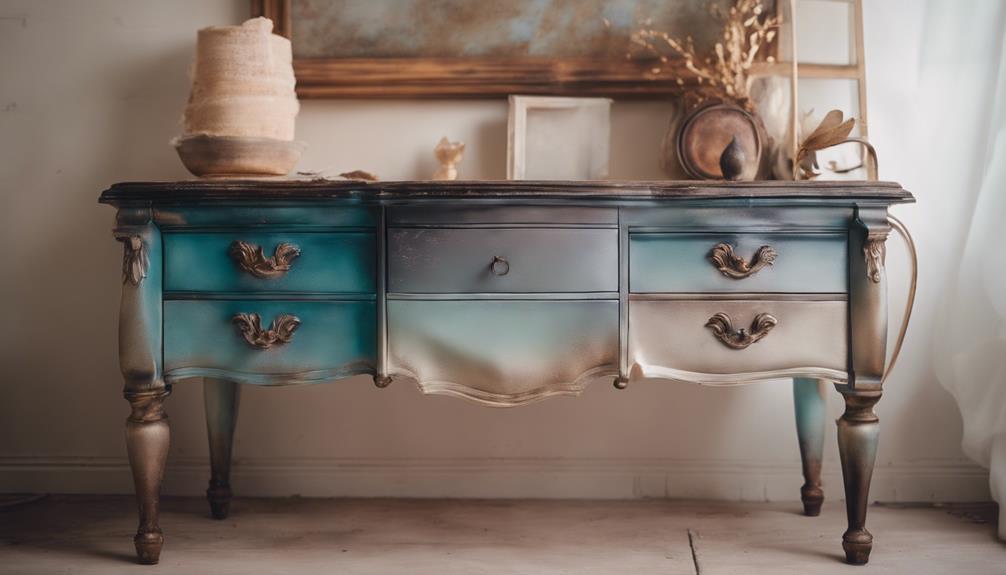
To enhance the visual appeal of painted furniture, consider incorporating special effects and techniques to create unique finishes and decorative elements. Experimenting with different finishes such as matte, metallic, distressed, and weathered looks can add depth and character to your pieces. Utilize quality brushes to achieve a smooth finish and prevent unsightly brush strokes. Incorporating decorative effects like stenciling and crackling can elevate the overall design of your furniture. For a more intricate touch, explore using decor moulds, floral transfers, and salt wash for unique effects that will make your furniture stand out. Another technique to try is layering chalk paint to create a textured finish, adding dimension and interest. By combining these techniques and effects, you can transform plain furniture into stunning statement pieces that reflect your personal style and creativity.
| Techniques & Effects | Description | Benefits |
|---|---|---|
| Quality Brushes | Ensure a smooth finish | Prevents brush strokes |
| Decorative Effects | Stenciling and crackling | Adds intricate designs |
| Different Finishes | Matte, metallic, distressed, weathered looks | Adds depth and character |
Achieving a Professional Look
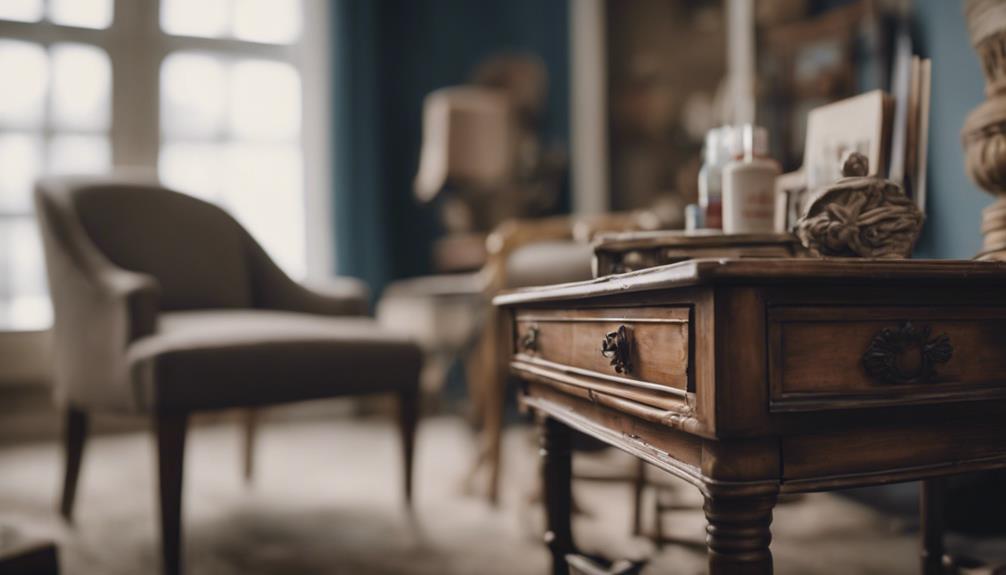
When aiming for a professional finish in furniture painting, the surface preparation techniques and tools chosen play an essential role. Properly prepping the surface through cleaning, sanding, and priming sets the foundation for a flawless outcome.
Selecting the right tools and materials, such as high-quality paint and sealants, guarantees a durable and polished look.
Surface Preparation Techniques
Implementing thorough surface preparation techniques is essential for achieving a professional look when painting furniture. To guarantee a high-quality finish, follow these steps:
- Prep Work: Start by inspecting the furniture for any existing finish, dirt, or grime. Remove these using appropriate cleaning products like Murphys Oil Soap to create a clean surface for painting.
- Sanding: Use medium and fine grit sandpaper to sand the furniture thoroughly. This process helps in creating a smooth surface for the paint to adhere to, ensuring a flawless finish.
- Cleaning: After sanding, clean the furniture again to remove any dust or debris. A clean surface is vital for paint adhesion and prevents issues like peeling or chipping.
- Smooth Surface: By following these steps diligently, you'll achieve a smooth surface that allows the paint to adhere evenly, resulting in a professional-looking finish on your furniture.
Choosing the Right Tools
Quality brushes and proper rollers play an important role in achieving a professional finish when painting furniture. Opting for high-quality brushes like Purdy White Dove 3/8 or Sherwin-Williams Mohair can have a major impact on the outcome.
Additionally, selecting the right tools, such as a foam roller or a paint sprayer, can contribute to a smooth and flawless application. The choice between a sprayer, roller, or brush can affect the final look of your painted furniture. Investing in excellent tools not only minimizes brush strokes but also ensures a polished result.
By utilizing proper rollers and brushes, you can reduce imperfections and achieve a professional appearance. Remember, the tools you use, along with the techniques applied, are important in attaining a flawless finish that exudes quality and expertise.
Make sure to select the appropriate paint brush or roller for the job to achieve the desired professional look.
Frequently Asked Questions
What Type of Paint Is Best for Furniture?
For furniture, the best type of paint depends on the desired finish and durability. Water-based paints, like Sherwin-Williams Emerald Urethane Trim Enamel, offer easy cleanup and low odor. They work well for most furniture projects.
However, if you need a more robust finish, consider oil-based paints. They provide extra durability but may have a longer drying time and stronger odor.
Ultimately, choose based on your specific needs for a professional and long-lasting result.
How Do I Decide What Color to Paint My Furniture?
When deciding on a color to paint furniture, several factors come into play. We first consider the existing room colors to ensure harmony and coherence in the overall design. Testing paint samples on a small area of the furniture piece can help visualize how the color will look in different lighting conditions. Seeking inspiration from various sources such as interior design magazines, online platforms, or even nature can spark creativity and offer unique color combinations.
Lighter hues are known to create a sense of space and airiness in a room, making it feel more expansive. On the other hand, darker colors tend to bring warmth and coziness, especially in larger spaces or rooms with high ceilings. Personal style preferences play a significant role in the decision-making process, determining whether to make a bold statement with a vibrant color or opt for a subtler accent to complement the existing decor.
Ultimately, the right color choice has the power to transform a space and set the desired ambiance. It's essential to take the time to choose wisely, considering your needs, preferences, and the overall atmosphere you wish to create. By carefully selecting a color that resonates with you, you can enhance the aesthetics of your furniture and elevate the look of your living space.
How to Paint Furniture for Dummies?
When painting furniture as beginners, start by sanding to guarantee paint adhesion. Use a quality primer like Zinsser Bulls Eye 1-2-3 for a smooth surface.
Opt for self-priming, self-sealing paints for simplicity. Apply a clear top coat like Polycrylic for durability.
Prepare by removing hardware and filling imperfections.
Following these steps will help achieve a successful furniture painting project, even for dummies.
What Is the Best Method for Painting Furniture?
The best method for painting furniture involves thorough cleaning, sanding, priming, and using high-quality paint for a professional finish. Opt for premium paint like Sherwin-Williams Emerald Urethane Trim Enamel for a durable, smooth result without a topcoat.
Remember key techniques like cutting in, rolling evenly, and sanding between coats for that flawless finish. Equip yourself with high-grade brushes and rollers like Purdy White Dove and Sherwin-Williams Mohair for smooth, even application.
Choosing self-priming paints can save time and skip the separate primer step.
Conclusion
To wrap up, painting furniture is an enjoyable and fulfilling DIY project that can completely change the appearance of any room in your home. By following the steps outlined in this guide, you can achieve a professional finish and create a piece that truly reflects your personal style.
So grab your paintbrush and get ready to express your creativity on your furniture, turning ordinary pieces into extraordinary works of art. Happy painting!
